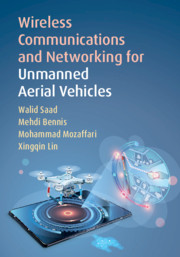Book contents
- Frontmatter
- Dedication
- Contents
- Acknowledgments
- 1 Wireless Communications and Networking with Unmanned Aerial Vehicles: An Introduction
- 2 UAV Applications and Use Cases
- 3 Aerial Channel Modeling and Waveform Design
- 4 Performance Analysis and Tradeoffs
- 5 Deployment of UAVs for Wireless Communications
- 6 Wireless-Aware Path Planning for UAV Networks
- 7 Resource Management for UAV Networks
- 8 Cooperative Communications in UAV Networks
- 9 From LTE to 5G NR-Enabled UAV Networks
- 10 Security of UAV Networks
- References
- Index
9 - From LTE to 5G NR-Enabled UAV Networks
Published online by Cambridge University Press: 31 March 2020
- Frontmatter
- Dedication
- Contents
- Acknowledgments
- 1 Wireless Communications and Networking with Unmanned Aerial Vehicles: An Introduction
- 2 UAV Applications and Use Cases
- 3 Aerial Channel Modeling and Waveform Design
- 4 Performance Analysis and Tradeoffs
- 5 Deployment of UAVs for Wireless Communications
- 6 Wireless-Aware Path Planning for UAV Networks
- 7 Resource Management for UAV Networks
- 8 Cooperative Communications in UAV Networks
- 9 From LTE to 5G NR-Enabled UAV Networks
- 10 Security of UAV Networks
- References
- Index
Summary
This chapter provides a practical discussion on the integration of UAVs into real-world cellular systems, ranging from long-term evolution (LTE) to 5G new radio (NR) and beyond. We first review the roles of mobile cellular technologies for UAV applications while highlighting the use of mobile connectivity and the role of mobile cellular technologies in enabling the development of new services for UAVs in key areas such as identification and registration, location-based services, and law enforcement. Then, we discuss LTE-enabled UAVs in more detail, including a tutorial on LTE and the various UAV use cases that include UAV LTE user equipment and UAV LTE base stations. We also touch upon some performance enhancing solutions that can optimize LTE connectivity for providing improved performance for UAVs while protecting the performance of terrestrial mobile devices. We then introduce various 3GPP standardization efforts on cellular-connected UAVs that aim to address the anticipated usage of mobile technologies by UAVs and regulatory requirements. Next, we discuss 5G NR-enabled UAVs while providing a primer on 5G NR essentials, how 5G NR can provide superior UAV connectivity, and the roles of network slicing and network intelligence for identifying, monitoring, and controlling UAVs in the 5G era.
Keywords
- Type
- Chapter
- Information
- Publisher: Cambridge University PressPrint publication year: 2020

